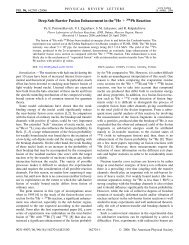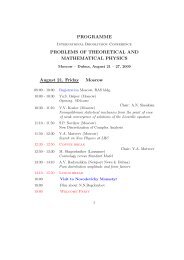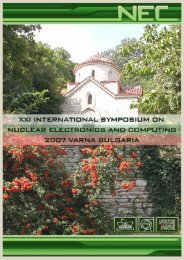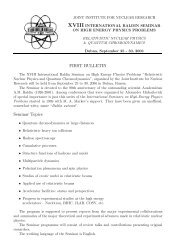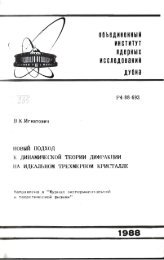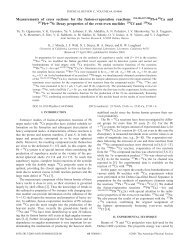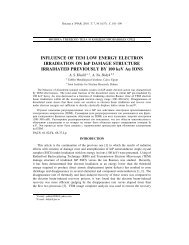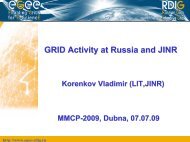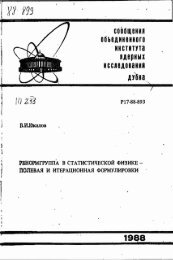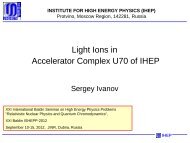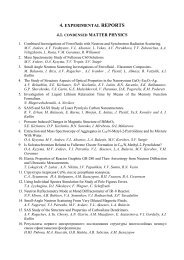Joint Institute for Nuclear Research Relativistic ... - Index of - JINR
Joint Institute for Nuclear Research Relativistic ... - Index of - JINR
Joint Institute for Nuclear Research Relativistic ... - Index of - JINR
You also want an ePaper? Increase the reach of your titles
YUMPU automatically turns print PDFs into web optimized ePapers that Google loves.
SOLVING BETHE-SALPETER EQUATION FOR THE SCATTERING<br />
STATES<br />
V.A. Karmanov 1† and J. Carbonell 2<br />
(1) Lebedev Physical <strong>Institute</strong>, Moscow, Russia<br />
(2) CEA, Saclay, France<br />
† E-mail: karmanov@sci.lebedev.ru<br />
We present the first solution <strong>of</strong> the Bethe-Salpeter (BS) equation [1]:<br />
∫ d<br />
F(p,p ′′ ,P) = K(p,p ′′ 4 p ′<br />
,P)−i ,P)<br />
(2π) 4K(p,p′<br />
×<br />
1 1<br />
[ (1<br />
[ P (1<br />
2 +p′)2 −m +iǫ]<br />
2 P 2 −p′)2 −m +iǫ]F(p ′ ,p ′′ ,P),<br />
2<br />
in Minkowski space <strong>for</strong> the scattering states, <strong>for</strong> the <strong>of</strong>f-mass-shell amplitude, <strong>for</strong> the<br />
one-boson exchange (OBE) kernel K. Solving this equation is a difficult task because<br />
<strong>of</strong> the existence <strong>of</strong> many singularities in the integrand. The singularities, <strong>of</strong> course, are<br />
integrable in a mathematical sense (due to iǫ in the propagators), but cannot be handled<br />
in a direct numerical way. Because <strong>of</strong> that, the BS equation <strong>for</strong> the scattering states was<br />
previously solved <strong>for</strong> the separable kernels (see <strong>for</strong> review [2]). For the OBE kernel, only<br />
the on-shell amplitude, determining the phase shifts, was found.<br />
Our method (valid both <strong>for</strong> the bound and <strong>for</strong> the scattering states) is based on an<br />
explicit analytical treatment <strong>of</strong> all the singularities. It can be applied both to equation<br />
without the partial wave decomposition and to the partial wave one. For the present, we<br />
consider the case <strong>of</strong> spinless particles.<br />
Using this method we first solve the bound state equation and reproduce our previous<br />
results, found in Minkowski space by another our method (see <strong>for</strong> review [3]).<br />
We find that the BS results <strong>for</strong> the phase shifts and <strong>for</strong> the scattering length considerably<br />
differ from the ones given by the Schrödinger equation. The relativistic effects are<br />
significant even at small incident energy.<br />
Above the meson creation threshold the phase shifts become imaginary. Then we<br />
calculate inelasticity.<br />
The <strong>of</strong>f-shell BS amplitude found in our work, after its generalization to the NN<br />
system, can be used <strong>for</strong> relativistic calculation <strong>of</strong> the deuteron electrodisintegration ed →<br />
enp, which is an inelastic analogue <strong>of</strong> the deuteron e.m. <strong>for</strong>m factors.<br />
References<br />
[1] E.E. Salpeter and H.A. Bethe, Phys. Rev. 84, 1232 (1951).<br />
[2] S.G. Bondarenko, V.V. Burov and E.P. Rogochaya, Few Body Syst. 49, 121, (2011).<br />
[3] J. Carbonell and V.A. Karmanov, Few-Body Syst. 49, 205 (2011).<br />
63



